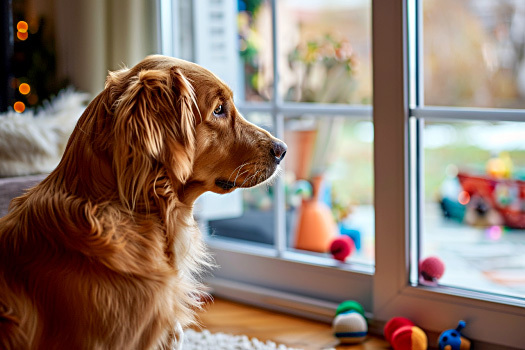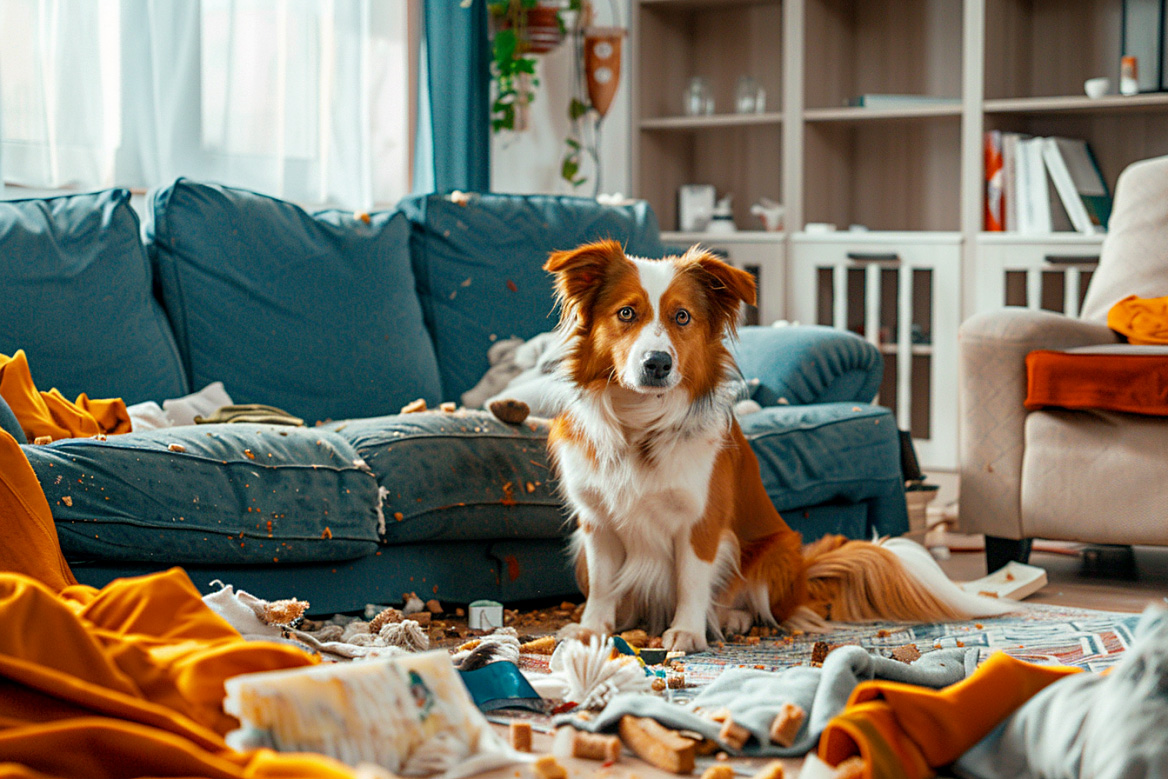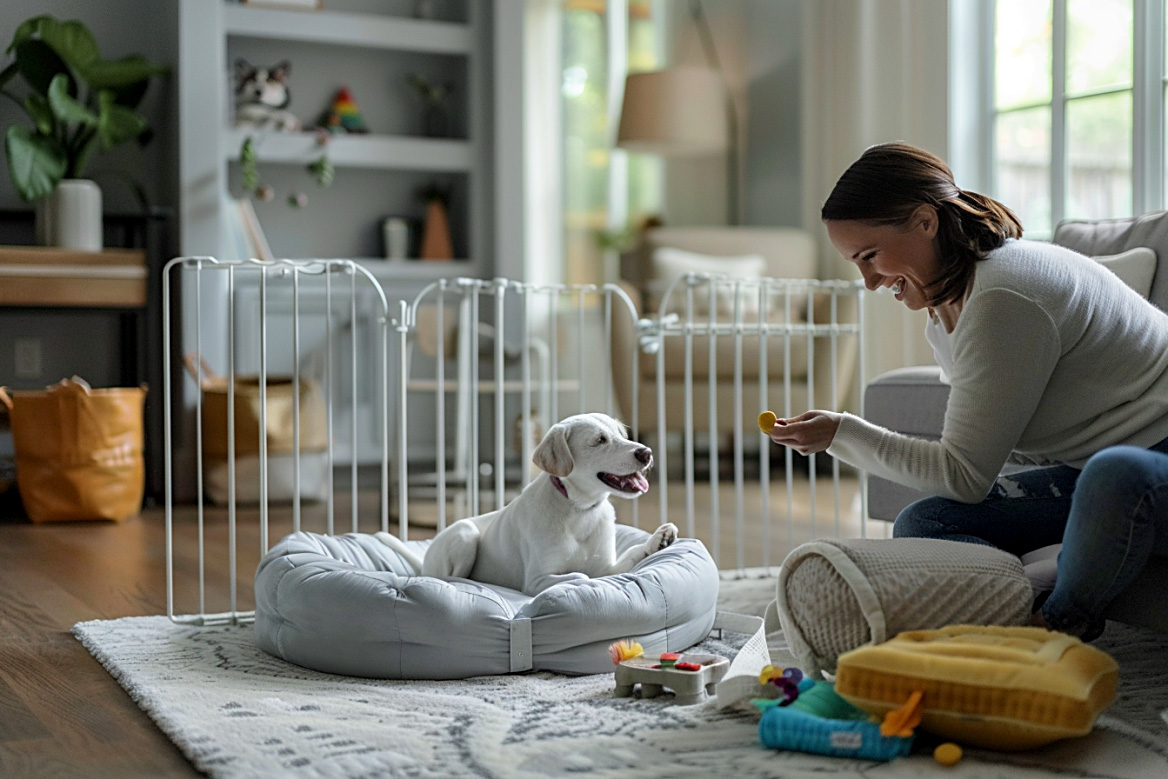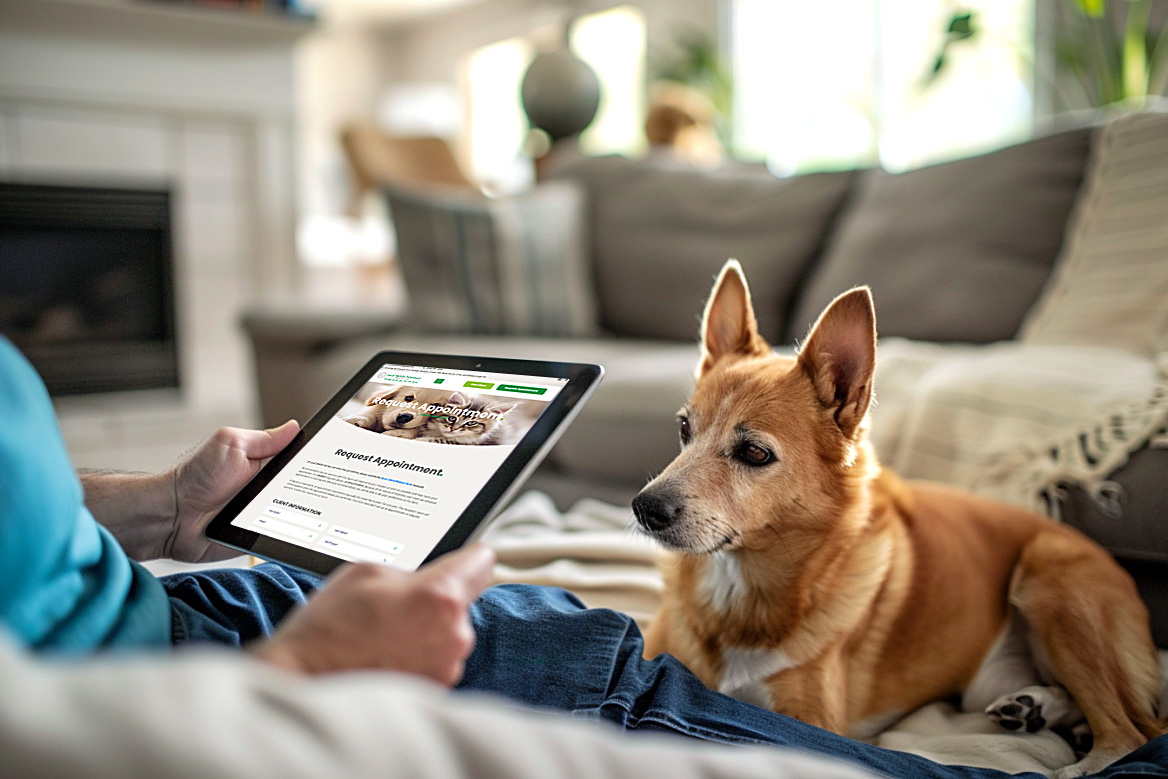- Servicing the Triangle Area: Raleigh, Durham, Chapel Hill, Wake Forest, Cary, and Hillsborough NC
Anxiety in Dogs
 Dogs are social animals and form strong bonds with people, so it is not surprising that they may feel somewhat anxious when separated from their social group. Most dogs adapt well to the typical daily separation from their owners. Unfortunately, problems can arise when an overly dependent dog develops a dysfunctionally strong attachment to its owners.
Dogs are social animals and form strong bonds with people, so it is not surprising that they may feel somewhat anxious when separated from their social group. Most dogs adapt well to the typical daily separation from their owners. Unfortunately, problems can arise when an overly dependent dog develops a dysfunctionally strong attachment to its owners.
The separation anxiety dog is distinguished by:
A) Signs of distress primarily when left alone
B) Over-attachment when the owner is present
Separation anxiety may be manifested as destruction to the owner’s property and other behaviors that may be dangerous for the dog or annoying for people sharing the dog’s environment. It is important to realize that the dog is not doing these things to get even with the owner for leaving the dog, out of boredom, or due to lack of obedience. These dogs are not being destructive out of “spite” or “anger”; they are truly distressed at the prospect of being left behind. Consider instead that the dog's dependence on the owner is so great that it becomes anxious when the owner leaves. The dog must find an outlet for this anxiety, and its methods of doing so may cause considerable damage. Also consider that, no matter how flattering the dog’s constant attention to the owners may seem, it is not fair to the dog to allow it to be so stressed by the owner's absence that it must resort to one of these unwanted behaviors to alleviate its tension.
When do Dogs Develop Separation Anxiety
For some dogs, the anxiety when left alone is evident as soon as the dog joins the household. In these cases, the dog may be genetically predisposed to anxiety, may have had inappropriate or insufficient socialization experiences during the juvenile period, or a combination of both. For some dogs, no initiating trigger can be identified. Symptoms of separation anxiety may develop gradually over time or may appear in full-blown form the first time they are left alone under the right circumstances.
The onset of separation anxiety frequently occurs after the dog is exposed to some experience that interrupts the social bond. This can occur when owners board the dog for vacation, a change in the owner’s work schedule, a household member leaves due to divorce, death, or college, or when the dog is relocated to a new house or household.
Overly indulgent owners may promote this condition in predisposed dogs and contribute towards its maintenance and exacerbation. Owners of dogs that experience separation distress are often nurturing, empathetic people who spend a lot of time with their dog. They allow the dog to follow them around the house and encourage the exuberant welcome the dog gives them when they return home. Less nurturing owners may help instill independence in the dog thus circumventing the worst throws of the problem and permitting its gradual resolution.
Other Separation-Related Behavior Problems
Separation anxiety may be confused with other separation-related behavior problems that occur in the owner’s absence but are not necessarily associated with an over-attachment to the owner. Such problems include excessive and destructive exploratory behavior, nuisance barking, unrelated house-training problems, and uncomplicated barrier frustration. These problems occur in dogs that are under-stimulated and do not necessarily indicate a dysfunctional bond with the owner.
Treatment of separation anxiety
 Break Cycle of Anxiety: One of the first steps in treating this condition is to break the cycle of anxiety. Every time the dog becomes anxious when the owner leaves, its frustration is reinforced until it becomes absolutely frantic every time the owner exits the house. “Doggie Day-care” or hiring a pet sitter often is a better alternative for dogs that initially are resistant to treatment.
Break Cycle of Anxiety: One of the first steps in treating this condition is to break the cycle of anxiety. Every time the dog becomes anxious when the owner leaves, its frustration is reinforced until it becomes absolutely frantic every time the owner exits the house. “Doggie Day-care” or hiring a pet sitter often is a better alternative for dogs that initially are resistant to treatment.
Counterconditioning: Owners should give the dog an acceptable item to chew, such as a long-lasting food treat only when they go out. The goal is to have the dog associate this special treat with the owner's departure. Treats to try include hollow bones stuffed with peanut butter or soft cheese, drilled out nylon bones, or hollow rubber chew toys such as Kong toys similarly enhanced (place in freezer before giving it to the dog to make it last longer). Give the bone to the dog before the owner is prepared to depart. The chew toy should be used only as a reward to offset the anxiety triggered by the owner’s departure. Hiding a variety of these delectable food treats throughout the house may occupy the dog such that the owner’s departure is less stressful. As an additional form of occupational therapy, the dog can also be fed its meals in a food puzzle (Buster Cube or Boomer Ball with holes drilled) and alternate it with the other food-stuffed toys; this will keep the dog occupied for a longer period at mealtime. Such delectable treats should be picked up upon the owner’s return.
Independence Training: Independence training is one of the more important aspects of the program and involves teaching the dog to “stand on its own four feet” when the owner is present with the express intention that the dog’s newfound confidence will spill over into times when the owner is away. The owner needs to make the dog more independent by reducing the bond between themselves and the dog to a more healthy level of involvement. Decreasing the bond is the hardest thing for most owners to accept. We all acquire dogs because we want a strong relationship with them, but the owner needs to accept that the anxiety the dog experiences in their absence is destructive to it. Essential components of the independence training program are as follows: Avoid catering to the dog's attention-seeking behavior; owners should ensure they initiate all interactions.
Owners should minimize the extent to which the dog follows them by teaching the dog to remain relaxed in one spot, such as its bed. To accomplish this, it is helpful if the owners train the dog to perform a sit-stay or down-stay while gradually increasing the time period that the dog holds the command and remains separated from the owners. If the dog will not remain in a sit or down-stay on command and insists on following, the owner can make use of a tether or kiddy gate. The dog should become accustomed to being separated from the owner when the owner is home for varying lengths of time and at different times of day. Owners can set up child gates to deny their dog access into the room in which they are doing something (i.e. reading, watching television, cooking, etc.). The dog should be instructed to lie down and stay on a dog bed outside the room. As previously mentioned, owners can provide an extended-release food treat or toy to keep the dog calm and distracted. Once the dog is able to tolerate being separated from its owners by a child gate, they can graduate to shutting the door to the room so the dog cannot see them. The dog should not be allowed to sleep in bed with the owner as this only fosters dependence. In fact, it is best if the dog is not even allowed to sleep in the owner’s bedroom. First, the owner needs to train the dog to sleep in its own bed on the floor in the owner's bedroom. The dog may have to be taken to its bed several times before it gets the message that the owner really wants it to sleep in its own bed. If the dog will not follow instructions, the owner may need to tie it to a fixture in the room with a short tether. Alternatively, owners can train the dog to enjoy sleeping in a crate to prevent unwanted excursions. Do not use a crate if it causes more anxiety and distress for the dog. Once the dog will tolerate sleeping in its own bed in the owner's bedroom, the owner can move the dog's bed outside of the bedroom and use a child gate or barrier to keep the dog out. Gradually move the dog’s bed by means of a mobile barrier or child gate which is incrementally relocated to oblige the dog to sleep closer to, and eventually where it is left when the owner is separated from the dog during the day. Always remember to reward the dog with praise or a food treat for remaining in its bed.
Departures and Returns: Many owners erroneously feel that if separation is so stressful, then they should spend more time with their dog before they leave. Unfortunately, this often exacerbates the condition. Everyone in the family should ignore the dog for 15-20 minutes before leaving the house and for at least 10-20 minutes after returning home. Departures should be quick and quiet. A non-emotional goodbye is acceptable as the owner gives the dog a long lasting food toy such as a Kong toy stuffed with peanut butter or cream cheese. Similarly, prolonged and exuberant greetings should be avoided. This evens out the emotional roller coaster ride that these dogs otherwise experience with overly emotional departures and exuberant greetings from owners when they return home. When departures and returns generate less anxiety and excitement, the dog will begin to feel less tension in the owner's absence. Remember to reward calm behavior.
Medication: Medication is often used in conjunction with the above treatment strategies and is generally helpful. Traditionally antidepressants like clomipramine (Clomicalm), fluoxetine, (Prozac), or amitriptyline (Elavil) are recommended. Clomicalm has recently been FDA approved for use in dogs to treat separation anxiety.
Additional Recommendations:
- Some dogs with separation anxiety actually manage to escape the house, so we recommend that the dog wear identification tags with a buckle collar. Owners may also want to consider tattooing or micro-chipping the dog so it can be identified if it panics and escapes.
- Audio or video recording the dog’s behavior when the owner departs can often help to confirm a diagnosis of separation anxiety.
- Make a tape recording of normal household sounds when the owner is home and play the tape for the dog when it is alone.
- Many people wonder about getting a pet for their dog so the dog won't be lonely when the owners are away. This almost never works, because the excessively tight bonding is between the owner and the dog, not between another animal and the dog. Having company has no effect on the distress the dog feels when the owner leaves.
- Owners may play tug-o-war games with the dog and let it win as such interaction builds confidence. However, if the dog starts to growl, it may be necessary to back off from this approach.
- Dogs should never be punished for the physical consequences of their distress when separated from the owners. In fact, punishment can exacerbate any underlying anxiety and worsen the behavior problem. Dogs do not make the association between making a mess and being punished for it at a later time. They also cannot reason that if they don't make a mess in the future, they won't be punished. Owners often report that their dog looks "guilty" when the owners return home to destruction or urine or feces on the floor. The dog is not exhibiting guilt as we know it. The dog has learned that when owners are present and a mess exists, the dog is in trouble. If someone who had never scolded the dog went into the house, and a mess was present, the dog would not look "guilty". In an attempt to avoid punishment, the dog may respond with submissive postures which the owner misinterprets as “guilt” or “remorse.” Submissive postures are actually an effort to appease the owner and avoid confrontation.

 How do I get my pet scheduled?
How do I get my pet scheduled?
If your pet is an existing patient of Local Mobile Vet, simply fill out the appointment request form, and we will reach out to get an appointment scheduled.
If we have never seen your pet before, fill out the New Client Form and we will reach out to help you determine if we are the right fit for you and your pet.
